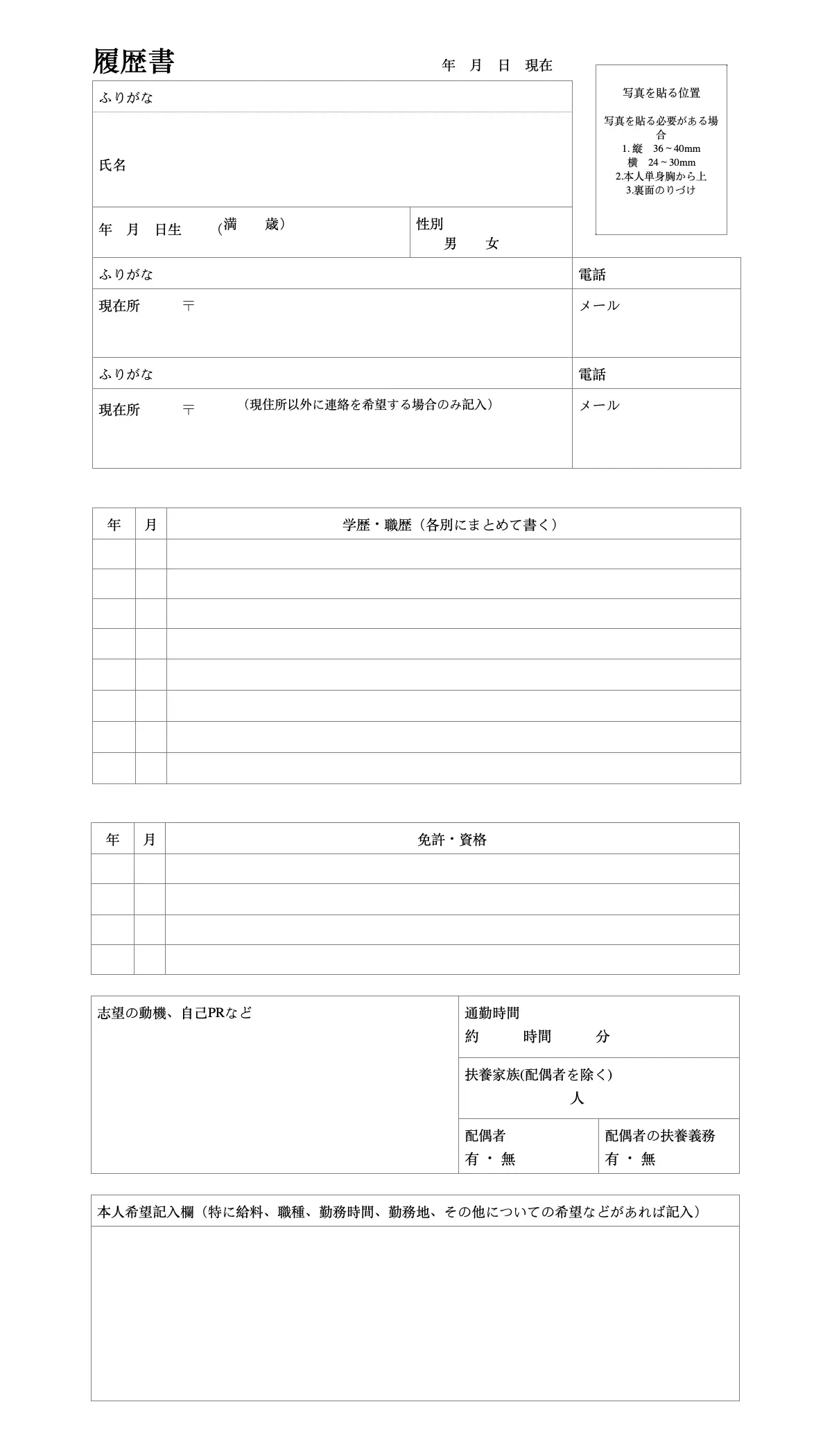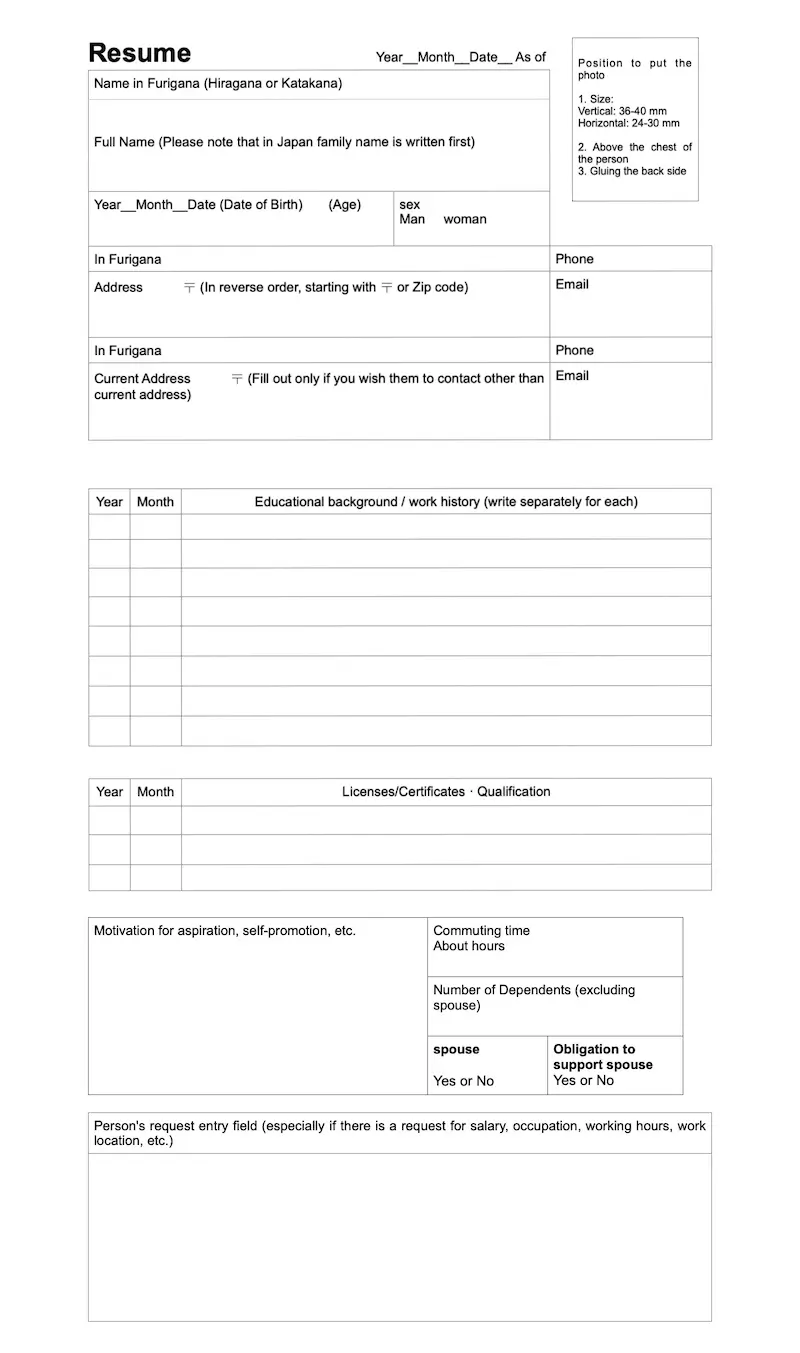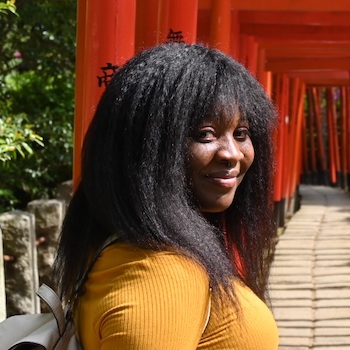How to Write a Japanese Resume: Rirekisho and Shokumukeirekisho

When you apply for a job at companies based in Japan, you might see the instructions about what type of resume you must submit. This may surprise some foreigners, but it’s crucial to know about writing and submitting Japanese-style resumes to apply for a job in Japan.
This article will discuss two types of Japanese resumes. Out of these two types, the “Rirekisho” has a standard template. We will discuss the template and below is a link from where you can download the template of the Japanese Rirekisho resume.
Japanese culture values processes and standardization more highly than most other cultures. Japanese resumes are no exception. Unlike other countries, resume formats are very standardized in Japan.
However, there are exceptions to the expectations of the type of resumes, and those multinationals with a diverse workforce, many foreigners, and modern and progressive Japanese tech companies.
Regarding the above statement, please note that depending on the domain, some multinational companies do not have diversity in the workforce. E.g., companies in auditing, consulting, and such domains.
Such companies need mainly Japanese employees; hence, the work environment, internal processes, and expectations are similar to traditional Japanese companies. Moreover, such companies would expect Japanese-style resumes from the candidates.
Types of Japanese Resumes
There are specific kinds of resumes to apply to Japanese companies, which are very different from Western-style resumes. There are two kinds of resumes commonly used in Japan. These are as follows:
- Rirekisho (履歴書): A brief personal history
- Shokumukeirekisho (職務経歴書): Career history
Japanese Resume – Rirekisho
If you are applying for a job with a traditional Japanese company or even a multinational that works in the traditional Japanese style, the Japanese resume “Rirekisho” is a must, along with the detailed resume called “Shokumukeirekisho.”
What is Rirekisho Resume?
Some dictionaries mention the meaning of “Rirekisho” as “Resume”. However, the literal meaning of Rirekisho is “Personal History”.
The word “Rirekisho (履歴書)” comprises three Kanji characters. These are as follows:
- 履: “Footwear,” “Walk” on, or “Tread.”
- 歴: “History of”
- 書: Document
If you look at the above-mentioned meanings of the Kanji characters, you will find that the meaning of the word “Rirekisho” is quite poetic and self-explanatory. The meaning is “History of your walk or treading your path.”
Quite poetic, right? So, the Japanese resume “Rirekisho” is a brief summary of your “personal” history. In Rirekisho resume, you do not have to mention work experience details.
Why Rirekisho Resume in Japan?
Traditionally, Japanese companies had a lifetime employment system in which candidates join a company right after graduation, and companies train them to carry out their work responsibilities. These work responsibilities may or may not be related to the educational qualification. Moreover, employees would stay with the same employer for life to retire from the same company.
During an employee’s career journey, the job role may change, and the employer provides the required training for the new role.
In fact, in the large traditional Japanese corporate world, this practice still continues.
In the above scenario, the candidates did not have any prior full-time work experience, and hence, a brief personal history of educational qualification and any part-time jobs was sufficient. And that’s why the existence of Rirekisho resumes.
In today’s Japan, large Japanese corporations still have the main hiring from universities like in the olden days. But, unlike in the past, some employees change jobs, creating the need for replacement by experienced talent. Moreover, the corporate sector is also realizing the need for change.
So, The brief Rirekisho resume practice and the detailed resume are still going on at companies with traditional Japanese work environments. However, now the Rirekisho serves as the resume summary before the hiring manager decides to review the detailed resume.
Details of Japanese Rirekisho Resume
Rirekisho (履歴書) is a two-page template for the basic Japanese resume, which is a must when applying to any traditional Japanese company. In this resume, a candidate lists all the facts about their education and experience in a “standard order“. Please note that modern Japanese companies do not require a Rirekisho.
Creating a Japanese resume is not directly translating your English resume into Japanese. There are specific differences in the formatting and writing that are mainly used when creating a Japanese resume. You can also download the rirekisho template online here to fill it out and send it by email, or print and send the hard copy of your Rirekisho resume.
These days, resumes are electronically submitted, but don’t be surprised to hear that some employers might prefer handwritten ones. Therefore, you can find a blank resume template from your local convenience store.
Make sure your resume is easy to read. If you are not used to writing kanji, it would be worth having a native speaker check your application before submission.
Parts of Rirekisho
The following are the parts that make your Rirekisho-style resume in Japan:
Basic Information
The first part of a standard Japanese resume covers the applicant’s basic information, including the full name (first, middle, and last), birthday, phone number, address, and photo.
Non-Japanese names should be written in capital letters starting with your last name, then first and middle names. The address should also be written in Japanese for easy reading. Be sure to include furigana for both your name and address as well.
We know that it’s uncommon to include a photo with Western resumes. However, in Japan, having a photo on the resume is a common practice. Some people may argue against putting the self-picture on the resume, but then they should complain to LinkedIn also :).
The photograph should be on a neutral background, showing your face clearly with non-distracting hair and make-up. You’re expected to look professional, so wear a nice shirt and a jacket. Residents in Japan often use the photo machines explicitly used for taking these types of photos. They’re usually found in shopping malls and train stations.
Education and Work History
The second section of the resume is for education and a brief employment history.
In this next section, you will need to list the names of the schools and the programs you studied. In the first line and center, enter gakureki (学歴) to denote education. You need to list the academic background from senior high school graduation. If you attended school out of the country, you could specify the country in brackets [] before writing the school’s name.
Below the educational section, you need to write your work history briefly. This is called shokureki (職歴).
To clarify that the following sub-section is for work history, please write shokureki (職歴) in the center to move on to employment history.
Start with the company that first hired you and end with the place where you’re currently employed.
You will see that the first two columns of this section are “年” (Year and “月” (month). Start with the date you entered the first company and right nyuusha (入社) after the company name. Then, in the subsequent line, write the date you left the company with taishoku (退職).
When you come down to the last line, and you’re still employed, write genzainiitaru (現在に至る) for currently still employed. At the end of the section, on the following line, write ijou (以上) to show the end of the section.
Licenses and Qualifications (Certifications)
The third section of Riirekisho is for writing about licenses and certifications you might have. Please note that these certifications are not about your main educational degrees.
Like the previous section, start with the month and year of the qualifications you earned.
Be sure to use the official names of qualifications (certifications) instead of the shortened acronyms, i.e., for the JLPT N1 certification, use 日本語能力試験1級. If you don’t have any qualifications here, then write tokuninashi (特になし) in the first line.
Self-Promotion, Hobbies, Family
The left column of the 4th section of the resume is “志望の動機、自己PRなど” (Shibō no dōki, jiko PR nado). This means “Motivation for applying, self-promotion, etc.”
Be sure to fill out the jiko-PR (Self PR or Self Promotion) in this left column of the 4th section of the resume with something that will give your future employer a better understanding of your skills and interests. Include your motivation for applying and any special skills and experiences that would make you stand out from other applicants.
The right-hand side of the 4th section of Rirekisho resume is used to give a bit more personal information about yourself. In this column you need to fill out the following personal details:
- Commute time from your home to the closest station or bus stop to go to the office
- Number of dependents, excluding Spouse
- Whether you need to support the spouse as a dependent
Please note that the number of dependents is mainly used for insurance purposes. If you have a spouse (In Japanse haigusha (配偶者)), circle “yuu (有)” for yes or “mu (無)” for no.
Next, you need to mention if your spouse is financially dependent on you and you need to support her. This information is also required for insurance and tax purposes. So, if you’re planning to support your spouse, circle “Yes,” but if your spouse is working, then circle “No.”
Personal Requests
The 5th section, or the bottom section of your Japanese Rirekisho resume, is for special requests.
Such special requests could be related to things like commuting issues or health concerns. Be aware that any requests you make will likely be discussed during the interview. If you don’t have any particular concerns, write kishakiteini Itagaimasu (貴社規定に従います).
Template of Japanese Resume Rirekisho’s Template


English Translation Rirekisho Template
Please note that the following English translation of the Rirekisho resume template used for applying to Japanese companies is just for your convenience and understanding and not for actual use when you apply to a Japanese company; the original template in Japanese must be used.


Shokumukeirekisho: Detailed Japanese Resume
The second resume which you submit along with the Rirekisho is known as “Shokumukeirekisho (職務経歴書)”. The translation of Shokumukeirekisho is “Job / Work History Document”. As the name suggests, this resume is to write about your work experiences in detail.
“Shokumukeirekisho” Japanese resume is like the resumes used globally. A Rirekisho only lists the bare facts without any scope for you to mention your experiences and achievements in detail. These bare facts might have been enough to make a hiring decision for fresh graduates by Japanese companies. However, a Rirekisho with its brief facts and figures doesn’t serve the purpose of hiring experienced candidates.
In today’s world, the list of just your education and past employers with titles can’t become the basis of a hiring decision. Hence, a Shokumukeirekisho allows you to elaborate on your experience and achievements.
A Shokumukeirekisho resume is similar to the resumes used in Western countries and does not force you to follow a specific template. However, one difference in this Japanese resume is that the Japanese Shokumukeirekisho resume includes some elements of a cover letter. Japanese people refer to this part as “Self-Promotion.”
Conclusion
While the detailed Japanese resume (Shokumukeirekisho) is the same as the resumes used globally, writing a Japanese Rirekisho resume may seem to be a bit intimidating at first.
However, once you write your first Rirekisho resume, you can modify it yearly as you move through your career in Japan.
Like all resumes, Japanese resumes are made to be easy to read and create a quick picture of your background. Be consistent with formatting to ensure neatness, and finally, have one Japanese native speaker check over your resume before submitting it.


Jamila Brown is a 5-year veteran in Japan working in the education and business sector. Jamila is currently transitioning into the digital marketing world in Japan. In her free time, she enjoys traveling and writing about the culture in Japan.

